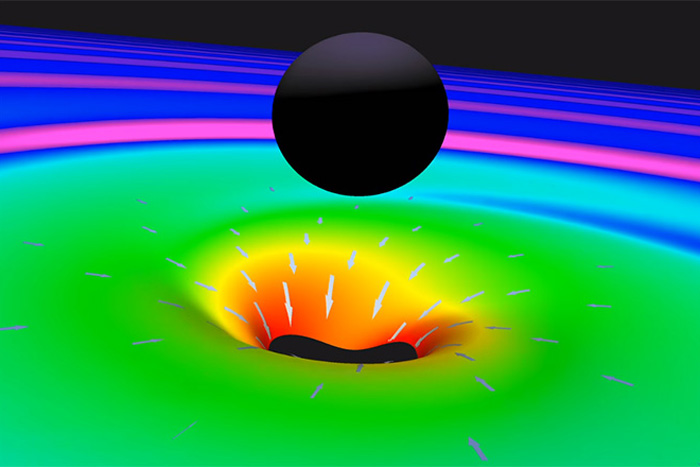Hawking: Gravitational Waves Could Revolutionize Astronomy

In the wake of last week's historic announcement of the discovery of gravitational waves by the Laser Interferometer Gravitational-Wave Observatory (LIGO), British physicist and black hole theorist Stephen Hawking was quick to congratulate the US-led collaboration, sharing his excitement for the historic news.
"These results confirm several very important predictions of Einstein's theory of general relativity," Hawking said in a BBC interview. "It confirms the existence of gravitational waves directly."
ANALYSIS: We've Detected Gravitational Waves, So What?
As is becoming clear, the direct detection of these ripples in spacetime not only confirm Einstein's famous theory of general relativity, they open our eyes to a previously "dark" universe. Astronomy uses the electromagnetic spectrum (such as visible light, X-rays, infrared) to study the universe, but objects that do not radiate in the electromagnetic spectrum will go unnoticed. But now we know how to detect gravitational waves, there could be a paradigm shift in how we detect and study some of the most energetic cosmic phenomena.
"Gravitational waves provide a completely new way of looking at the universe," said Hawking. "The ability to detect them has the potential to revolutionize astronomy."
Using LIGO's twin observing stations located in Louisiana and Washington, physicists not only detected gravitational waves; the gravitational waves they detected had a very clear signal that closely matched theoretical models of a black hole merger some 1.3 billion light-years away. Already, from initial analysis of the black hole merger signal, Hawking has realized that the system seems to align itself with theories he developed in the 1970's.
ANALYSIS: Hawking Tries to Find Black Hole's Emergency Exit
Breaking space news, the latest updates on rocket launches, skywatching events and more!
"This discovery is the first detection of a black hole binary system and the first observation of black holes merging," he said. "The observed properties of this system is consistent with predictions about black holes that I made in 1970 here in Cambridge."
Hawking is perhaps most renowned for his work on melding quantum theory with black hole physics, realizing that black holes evaporate over time, leading to his involvement in the fascinating "Firewall Paradox" that is continuing to rumble throughout the theoretical physics community. But here he refers to his black hole area theorem, which forms the basis of the "second law" of black hole mechanics. This law states that entropy, or the level of disorganization of information, cannot decrease within a black hole system over time. A consequence of this theorem is that should two black holes merge, like the Sept. 14 event, the combined event horizon area "is greater than the sum of the areas of the initial black holes." Also, Hawking points out that this gravitational wave signal appears to be in agreement with predictions based on the "no-hair theorem" of black holes, basically meaning a black hole can be simply described by its spin, mass and charge.
The details behind how this first gravitational wave signal of a black hole merger agrees with theory are complex, but it is interesting to know that this first detection has already allowed physicists to confirm decades-old theories that have, until now, had little to no observational evidence.
ANALYSIS: We Just Heard the Spacetime 'Chirp' of Black Hole Rebirth
"This discovery also presents a puzzle for astrophysicists," said Hawking. "The mass of each of the black holes are larger than expected for those formed by the gravitational collapse of a star — so how did both of these black holes become so massive?"
This question touches on one of the biggest mysteries surrounding black hole evolution. Currently, astronomers are having a hard time understanding how black holes grow to be so massive. On the one end of the scale, there are "stellar mass" black holes that form immediately after a massive star goes supernova and we also have an abundance of evidence for the existence of the supermassive behemoths that live in the centers of most galaxies. There is a disconnect, however.
If black holes grow by merging and consuming stellar matter, there should be evidence of black holes of all sizes. But "intermediate mass" black holes and black holes of a few dozen solar masses are astonishingly rare, throwing some black hole evolution theories into doubt.
VIDEO: Gravitational Waves Confirmed: A Historic Discovery
With the detection of gravitational waves on Sept. 14 came the realization that a black hole binary merger caused it. Two black holes, "weighing in" at 29 and 36 solar masses, collided and merged as one, generating a very clear gravitational wave signal. But, as pointed out by Hawking, how black holes of this specific mass came to being could provide some clues as to how black holes grow.
One thing is clear, however: This is the first time that we've acquired direct evidence of a black hole merger — a key mechanism that underlies black hole evolution theories — so it's good to know we're on the right track.
Watch the full BBC Stephen Hawking interview here:
Originally published on Discovery News.
Ian O'Neill is a media relations specialist at NASA's Jet Propulsion Laboratory (JPL) in Southern California. Prior to joining JPL, he served as editor for the Astronomical Society of the Pacific‘s Mercury magazine and Mercury Online and contributed articles to a number of other publications, including Space.com, Space.com, Live Science, HISTORY.com, Scientific American. Ian holds a Ph.D in solar physics and a master's degree in planetary and space physics.
